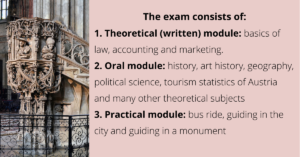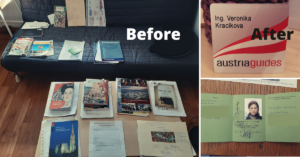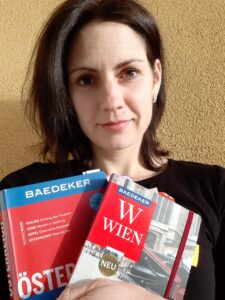
In this article I want to explain you, what is it the Austria Guide certificate, because I have an experience from first hand. So, it is a license given by the Austrian Chamber of Commerce to those successful candidates, who pass the exam and therefore become official tour guides of Austria.
In order to be able to accompany tourists in Austria, one must take a specialized course in one of the federal states and pass the exam at the Austrian Chamber of Commerce.
The badge is the same everywhere
The courses are held in all the capital cities of the Austrian federal states and are equivalent. It means that when a licensed guide moves from Bregenz (the westernmost part of Austria) to Vienna and wants to guide there, he can do so, because he has a universal badge. This is used sometimes by those, who live in Vienna, and want to finish the course in faster pace and enjoy an easier exam. Typically, in Linz or Eisenstadt. Because in Vienna, the amount of things to learn is way bigger than elsewhere.

Written module
The main objective of the law basics is to make the future guide acquainted with the legal regulations of this activity in Austria, what is allowed and what other business activities can one run under the license. This can be for example the additional sale of small goods or organising events. Most, if not all of this information, can be found on the web pages of the Austrian Chamber of Commerce in German language.
In accounting, of course, the backbone is the issuance of invoices, detailed information on the value added tax on both your services as well as the goods and services you purchase within your business. And, of course, you will learn to issue your own tax declaration, including the correct calculation of the income tax.
Marketing contains a lot of theory.However, the future guides can practice possible marketing strategies for their business on practical examples. In Austria, as elsewhere inEurope, the guide is a freelancer and has much of his publicity in his hands.
Oral module
Unlike some other exams I have done in my life, there is no “questions lottery” here. The three-member commission asks questions as they come to their mind and all you know is that many of the questions will be from the fields of art history and history.
Next, the commission will show you some pictures. It is necessary to know what it is, where it is located and you need to be able to give an appropriate commentary. It can be a piece of art from the Museum of Art History, a ceiling fresco of the oldest Romanesque house in Vienna, a monument from another town in Austria or an object from the Imperial Treasury. I my case, I received the crown of Rudolf II. which is located in the Imperial Treasury.
And the rest of the questions can be from any other field. As a foreigner, I was asked about the highest mountain in the country (warm-up) and then the details of the Austrian constitution.
Practical module: bus ride, guided tour in the city and commentary in a monument
In this part of the exam, the candidates arrive at the designated place, are divided into buses of maximum of 6 people in each group. They are called to the microphone in the front seat of the bus, one by one. Once they are seated, the examiners tell them where to go. Attention! They should not be just talking, they must give directions to the bus driver. Each candidate is also obliged to give explanation in a foreign language. I chose English, meaning I only alternated between German and English.
After getting off the bus, there is a guided tour. In my case, we got started from the Museum of Applied Arts (MAK) and walked through the city to Judenplatz. Each candidate received a certain section. Then came the surprise moment, when the commission was leading us to a monument, where we were supposed to give a commentary, but no one knew until the last moment, which it would be. It was a hot summer that day, so the commission took us to the cold Imperial Crypt, and there each candidate had to guide approximately ten minutes in certain section. Again in both languages.
The exam is really difficult, as you can see, but it is an amazing feeling to hold the precious tour guide pin in your hands!

How much does it cost and where can you apply for the course?

There are three institutes that offer this kind of courses courses in Vienna. WIFI Wien, BFI and Institutu Dr. Rampitch. The whole course, that takes from one to four semesters – depending onthe intensity – costs usually between 3000 – 5000 €.
The exam of three modules as described above costs nearly 500 €.
